Tom's Guide Verdict
The Xbox Series X is the pinnacle of Microsoft's gaming efforts, blending the promise of powerful next-generation performance with superfast loading times and a huge library of games spanning multiple Xbox generations.
Pros
- +
The only Xbox you need
- +
Lots of power
- +
Games load very fast
- +
Clean and cool design
- +
Stellar backwards compatibility
Cons
- -
Few next-gen launch games
- -
Large and heavy
Why you can trust Tom's Guide
Microsoft's Xbox Series X is the ultimate Xbox for a pretty simple reason. It's the best console on which to play not only the latest Xbox games but also a wealth of classic Xbox titles spanning multiple generations.
Having been out for almost four years, the Xbox Series X is readily available and has even been discounted to a price that borders on "impulse buy" territory. Plus, it's built up a solid library of must-play games from both Xbox Games Studios and third-party partners. And you can also enjoy enhanced versions of some of the best Xbox One games too.
People expecting a new console generation to blow their minds from the previous one might be a bit disappointed, as the graphics leap from the Xbox One X to Series X isn't earth-shattering, though games like Forza Horizon 5 and Senua’s Saga: Hellblade II are very visually impressive. But it does mean a lot of games that may have chugged on older hardware will run much more smoothly and at 4K resolution.
Furthermore, there's just a lot of other stuff to admire about the Xbox Series X. So read on for our full Xbox Series X review to see whether the new console has been worth the wait, and be sure to check out our guide to the best hidden Xbox Series X features to get the most out of this console.
Xbox Series X specs
| Header Cell - Column 0 | Xbox Series X | Xbox Series S |
|---|---|---|
| Price | $500, £449, AU$749 | $300, £249, AU$499 |
| Processor | Custom AMD Zen 2, 8-core, 3.8GHz | Custom AMD Zen 2, 8-core, 3.8GHz |
| GPU | AMD RDNA 2, 12 teraflops, 1.8 GHz | AMD RDNA 2, 4 teraflops, 1.6 GHz |
| RAM | 16GB | 10GB |
| Storage | 1TB | 512GB |
| Display (Targeted) | 4K, 60 fps | 1440p, 60 fps |
| Display (Max) | 8K, 120 fps | 1440p, 120 fps |
Xbox Series X review: Price and availability
The Xbox Series X launched for $499 in the U.S. in November 2020. Over in the U.K., it initially cost £499 before getting a surprise price hike and jumping to £479. It was a similar story in Australia as the price increased from AU$749 to AU$799.
However, there's little need to pay full price for the console regardless of where you live now. While the Xbox Series X was pretty darn hard to find in stock out of the gate, it's since become a little easier to buy, and we've even started to see quite significant discounts even outside of busier seasonal sales events.
In the runup to the holidays last year, the Xbox Series X hit its lowest price ever of $349, and this offer even included a free copy of Diablo 4. We expect to see deals of similar quality over the coming months, so be sure to shop for the best discount.
Xbox Series X: Design
You’d be forgiven for saying that the Xbox Series X looks like a small-form-factor PC, because it does; at least when it’s standing upright. Its monolithic design could be seen as uninspired. But I rather like the system's clean and unfussy appearance. It’s big, however.
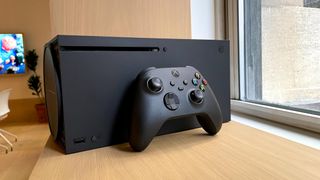
Measuring 15.1 x 15.1 x 30.1 centimeters (5.9 x 5.9 x 11.9 inches) and weighing 9.8 pounds, the Series X is a rather bulky machine, though not as large as the PS5. This means you’ll struggle to fit it into an entertainment unit, unless you place the device on its side. There’s a quartet of soft pads on one side of the console to show you which way it should be positioned when lying sideways. These also prevent the console from slipping around.
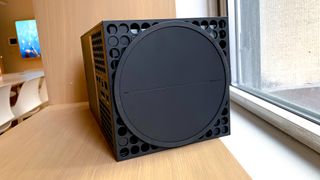
I think the Xbox Series X looks a little clunky and clumsy on its side, a bit like the lovechild of an audio amplifier and a brick. I keep mine upright and sitting partially behind my TV, and it looks rather nice in that space, particularly as you can peer into the top vent of the console, which has some green accents around the holes towards the middle.
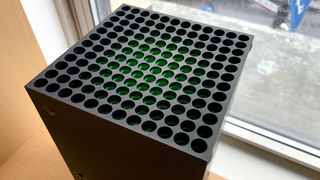
Given that the Series X sucks in cool air through the bottom of the console and vents it out the top, I think orienting the console vertically is probably better for its cooling system. Speaking of which, that system runs very quietly and coolly, though you can feel a waft of heat if you touch the top vent. It’s a testament to the engineering Microsoft has put into the Series X, given its powerful hardware in a rather compact form. You'd struggle to make a gaming PC this small with equivalent capabilities.
In fact, while it might look a little clunky peeking out from behind my TV, I think the Series X looks rather good sitting on a desktop. If you plan to plug the system into a 4K or high-refresh-rate monitor, you could be pleasantly surprised.
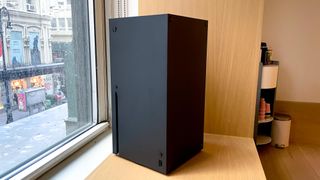
While I wasn't a fan of the VCR-like look of the original Xbox, the Series X appears to be borrowing from the clean design of the Xbox One X, only making it bigger. There’s no light bar here or spinning LED rings. Rather the only illumination comes courtesy of a jewel Xbox power button that glows a clean white when the Series X is turned on.
I don't think the Xbox Series X will go down in console history as a high point in tech design. But the simple aesthetic isn’t likely to age rapidly, and I reckon it’ll easily become something that melds into your entertainment setup.
As an aside, there was some chatter about concerns that the Xbox Series X vents can get clogged with dust, but there's been no hint of this with the Series X consoles the Tom's Guide team has.
Xbox Series X review: Ports
Keeping with the clean look, the Xbox Series X has only a USB 3.1 Type-A port and a Blu-ray disc drive on the console’s front. There's also a wireless controller pairing button. That makes it very easy to quickly plug in a controller to charge, or an external hard drive to transfer games and saves to and from the Series X.
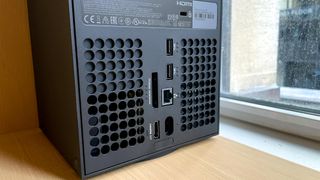
Around the back of the Series X, there’s a much wider port selection. You’ll find one HDMI 2.1 port: crucial for gaming at 8K, and allowing TVs with 120 Hz panels to take advantage of the 120 frames per second frame rate for certain games. (See the best gaming TVs for recommended models with HDMI 2.1.) There are also two more USB 3.1 ports - handy for external storage that you plan to keep connected to your console - as well as an Ethernet port and Kensington lock.
There’s no optical audio connection or HDMI-in port, like there were on the Xbox One and One X. However, dropping optical audio is likely to be a pain for only people with powerful audio systems, and the HDMI connection can still carry Dolby Atmos and surround sound signals. We’re not really sure if many people used the HDMI-in, so dropping it from the Series X isn’t a big deal. It also avoids any chance of plugging an HDMI cable into the wrong port, then wondering why your TV isn’t getting a signal: something that's happened to me before.
The most noteworthy port however, is the expansion slot. This is for the proprietary external PCIe 4.0 SSD that will let you expand the Series X with an extra 1 TB of speedy storage.
Xbox Series X: Interface and Quick Resume
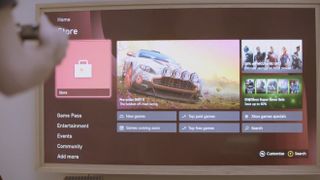
You'll be disappointed if you were expecting a big user interface change with the Xbox Series X, as its UI is pretty much identical to that of the Xbox One. That’s not a bad thing, as that UI was pretty comprehensive, with a whole suite of options from managing games and apps, to transfer data between drives, to finely calibrating HDR displays and audio kit.
There are all manner of interesting options that carry over from the Xbox One to the Series X, such as the ability to remotely access your console and stream games over a local Wi-Fi connection. Eventually, we expect to be able to stream games from the Series X over cellular broadband. But that was part of Microsoft's Project xCloud game steaming initiative, and has yet to be integrated into any Xbox console.
However, if you have an Xbox Game Pass Ultimate subscription, you can stream a range of Xbox games to an Android device, and those will sync with the progress you’ve made on the Series X or Xbox One. In fact, cross-platform syncing is one of the joys of the Series X. As soon as I installed Xbox One games on the Series X, the interface pulled my saves from the cloud and allowed me to carry on from where I left off.
Speaking of Xbox Game Pass, a lot of the Series X’s UI is geared around highlighting what’s new on the subscription service, which is pretty handy if you’re after a new game to play. This Xbox Game pass focus, plus the overall tile menu format can make it a little fussy, and occasionally tricky, to find what you’re looking for, unlike the very clean PS4 interface. But anyone familiar with the Xbox One UI will be completely at home on the Series X. It further stands to highlight how the Series X is less of a next-gen console, and is instead the flagship for an Xbox ecosystem.
If time is money, then the Xbox Series X is going to save you a lot.
One of the best new UI features is Quick Resume. In a nutshell, this allows you to have multiple games loaded up at the same time, and lets you jump out of the action in one title, then start another game, then jump back into the first game exactly where you left off, almost as if you’d simply paused.

This doesn't happen instantly, but it’s much faster than loading games from scratch. And there are now a good deal more optimized games for Xbox Series X and Series S that can take advantage of Quick Resume, not that both consoles have been out for a few months.
Quick Resume is a joy to use as well. Simply hit the Xbox button on the controller when you’re in one game, navigate to another title and it’ll load up. Then, hop back to the game you were playing first, and you’ll be able to continue from exactly where you left off.
It feels like a true game-changer and is a feature that the PS5 doesn't have an equivalent of, though PS5 games do load very quickly. I found that Quick Resume is fantastic when you want a quick burst of gaming or want to hop from a single-player game into a multiplayer one when your friends come online.
Xbox Series X review: Performance
There are now more Xbox Series X optimized games than there were at launch, showcasing what the 12 teraflops of graphics power can do when it’s applied to patched games, both old and new.
One of the standout titles is Assassin's Creed Valhalla. While not a Xbox Series X exclusive it's a game with impressive visuals and graphics setting, and is best played on new games console hardware. When it first launched on the Xbox Series X its performance left something to be desired as there were frame rate drops, some screen tearing and an overall performance profile that didn't stand up to the PS5 version.
But after a major patch, the game runs a lot more smoothly on the Xbox Series X. It targets 60 frames per second, and in my experience mostly reaches that. But it uses a dynamic resolution, which can scale from 4K down to 1440p when there's a lot of action on the screen. So it’s not delivering a true 100% native 4K experience.
Maybe it’s a testament to the quality of the upscaler in my 4K TV, but I can't really tell when there was a resolution drop. And for a game that looks as good as Assassin's Creed Valhalla, it’s impressive that a $500 box is pumping out crisp visuals and a steady frame rate; similar performance on a PC would require an investment of at least $1,000.

Gears 5 is one title that has been given the full Xbox Series X optimization treatment. That means it can run at 4K resolution and 60 frames per second, or 120 fps if you have a compatible TV.
If you own an Xbox One X, then you may have already played Gears 5 at 4K and 60 fps, as the console supports that. However, that’s a best-case scenario, and the One X will downscale resolution in favor of frame rate when there's a lot going on in the game. This can still happen on the Series X-optimized version of Gears 5, but the 12 teraflops of graphics power means that the system usually maintains a 4K presentation and a reasonably steady 60 fps.

Again, that might not sound too impressive until you realise there’s quite a bit going on to upgrade Gears 5’s visuals over the One X version. It's basically using the Ultra settings found in the PC version, which improves texture detail - though you’ll need to look pretty closely to notice huge differences - as well as better lighting and improved shadow details.
The game also uses something called "screen space global illumination," which could be best explained as a "ray-tracing lite." This has the result of illuminating areas that might otherwise be a lot darker, as well as showing muzzle flashes reflected in the chunky Gears armor.
I’m not going to say these upgrades represent a step into next-gen gaming, but they certainly look impressive and show off Gears 5 in its best light (quite literally). The game looks utterly fantastic and runs smoothly.
Interestingly, Gears 5 doesn’t run on the Xbox Series X’s Velocity Architecture, which promises to deliver super-fast loading times. But it almost doesn't need to, as it loads games in under 10 seconds. On an Xbox One X, you’re looking at loading times of 40 seconds or more.

But the most noticeable difference was in Red Dead Redemption 2. Given the size of the game’s open-world, it’s no surprise that on the One X, a save file takes well over a minute to load up. In one test, it took 1 minute 28 seconds to load from the main menu into my most recent game save. On the Series X, the same save took only 38 seconds to load, which is a huge improvement. If time is money, then the Series X is going to save you a lot.
As RDR2 hasn't been optimized for Series X, it will run at 4K, but won't run beyond 30 fps. However, it seems to stick rather firmly to the 30 fps mark, whereas on the One X, I’d occasionally encounter frame rate drops. I hope Rockstar releases an update that enhances Red Dead Redemption 2 for the Series X, as I have a feeling the new console would be able to run the game at 60 fps and 4K, helping add an extra layer of polish to a game that’s already spectacular to behold.
Xbox Series X review: Games

The Xbox Series X didn't launch with a vast amount of games, but it now has an enviable library of titles that are more next-generation than they are cross-platform.
Highlights include Forza Horizon 5, Halo Infinite and Elden Ring, with a slew of oddball games like The Ascent and Chorus, to take advantage of the console's hardware. Even Assassin's Creed Valhalla, a proper cross-gen game, benefits massively from running on the Xbox Series X.
It is worth noting that these are not Xbox Series X or Series S exclusive games, as they are available on Windows 10 and Windows 11 PCs. But I'd argue unless you have one of our best gaming PCs or best gaming laptops, they are worth playing on the flagship Xbox.
However, one game that's sure to put the Series X's power to the test is Starfield. This huge sci-fi adventure and role-playing game could be one of the biggest releases yet for the current-generation Xbox.
Xbox Series X review: Xbox Game Pass

Xbox Game Pass has been around for a while now, offering an easy way to get access to a suite of games for a rather affordable monthly price of $9.99 or £7.99. This has long made it one of the best bargains in the gaming world.
But I'd argue that Game Pass is an essential partner for the Xbox Series X. While the aforementioned launch line up of Xbox Series X games might be a little lacking, Game Pass provides a huge range of new and old games to play on the flagship console. Furthermore, many of these come with Xbox Series X and Series S enhancements, meaning the Xbox Series X is the best place to play such games you may have missed on the Xbox One.
Fork out $14.99 or £10.99 a month and you'll get access to Xbox Game Pass Ultimate, which provides access to Xbox and PC games, as well as cloud streaming and save syncing between all three platforms. It's simply a fantastic deal — in fact, right now I'd go as far as to say that Xbox Game Pass is the best deal in gaming.
What's more a whole suite of upcoming Xbox One and Series X games will be released day-one on Game Pass, meaning its one of the most affordable ways to get new games.
Xbox Series X review: Backwards compatibility
In the run-up to the release of the Xbox Series X, backwards compatibility was touted a lot by Microsoft, as well as keen Xbox gamers. Such was the hype, I had steeled myself for disappointment. But I needn’t have worried as backwards compatibility on the Xbox Series X is superb.
Simply put, getting an Xbox game from any generation to run on the Xbox Series X is just a case of getting the disc and popping it into the console. If the game is backwards compatible, and many should be, then it’ll begin an installation process. If you have access to Xbox Game Pass, then you can simply download any game that’s listed on the service that dates back as far as the original Xbox.
These games won’t immediately be able to put the graphical horsepower of the Series X to use, if ever. But the fact they can be installed directly to the console’s SSD means they’ll load up in seconds. And any games that used to run badly on older hardware, should at least be a little smoothed out.
There are limits in that a game locked at 30 frames per second won’t suddenly run at 60 fps or more unless it gets optimized. I found that to be the case with Red Dead Redemption, which runs at 4K/30 fps on the Series X, much like it did on the One X. Throwing Assassin's Creed 2 in the Series X results in a game that loads a lot faster and feels smoother than it ever did on the Xbox 360.
As Digital Foundry explains, Xbox One games with high-performance targets, performance modes, or dynamic resolution scaling, tend to run at the best settings available to them on the Series X, thanks to the console's raw graphical power. It’s important to point out that the Series X runs these games in a backwards compatibility mode, which means they won’t really be able to benefit from the GPU improvements AMD’s RDNA 2 architecture brings to the table, unless they are optimized at a later date.
I’m really hoping Microsoft encourages developers to patch older games to take advantage of the Series X’s power. Microsoft could also create a system that allows the Series X to bring its full might to bear on older games. But in the meantime, the backward-compatible games roster keeps expanding with Microsoft adding another 76 original Xbox and Xbox 360 games to the library, including 37 that can benefit from FPS Boost, a feature that boost game frame rates even without developer implementation.
One backward compatibility feature I'm rather impressed by is Auto HDR, which uses machine-learning to effectively apply high dynamic range to games that were never mastered for HDR. In Red Dead Redemption and Gears of War Ultimate Edition, I think the effect works rather well.
As with a lot of AI-based tech, this has the potential to go wrong, and oversaturate or overexpose some scenes. But I didn’t encounter any issues, and even Assassin’s Creed 2 looked rather nice, though the effect wasn’t hugely pronounced.
Combine this feature with the Xbox Series X’s power to basically bulldoze over unoptimized older games, and the Series X is arguably the best console on which to play Xbox games, from the latest Xbox One titles back to original Xbox games. And I feel there’s a lot more potential for backward compatibility to be improved once the Series X is out in the wild.
Xbox Series X review: Controller
Ever since Microsoft came up with the Xbox 360 controller, I’ve been a fan of the Xbox controllers, and the new Xbox Wireless Controller is a neat evolution of its predecessor. Though glance at the peripheral, and you’d be hard-pressed to spot any major differences from the Xbox One controller.
But that’s not a bad thing, as it’s a fantastic controller. Small improvements like textured triggers and an improved D-pad take a familiar controller and simply make it better.
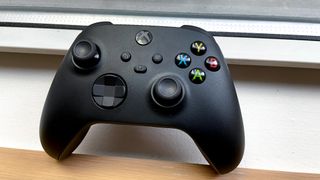
The Xbox Wireless Controller has long been one of the most comfortable controllers I’ve used, taking the Xbox 360 controller and building upon it. And the same is true with the new controller, though it does have a few extra features.
From a quick glance, the most notable change is the addition of a share button for sharing screenshots and recordings with a simple tap. You’ll then notice that the D-pad is a hybrid one: a concave disk that should deliver more precision, particularly if you play traditional beat-em-ups. The finish on the new controller has a more matte look, with the black appearing smokier. The Xbox button is also now all-black.
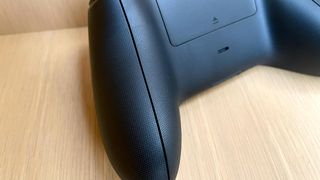
The new controller fits my hands almost exactly like its predecessor. The triggers are slightly smaller and feel a little more tactile, as do the shoulder buttons. And the joysticks have a firmer, more satisfying click to them than those on the older controller.

None of these changes are revolutionary — if you want that then check out the PS5’s DualSense controller — but they all add up to a nicely evolved Xbox Wireless Controller. The only real hiccup is that the controller still gets its power from AA batteries. While they can be replaced with a rechargeable battery pack that charges via USB-C, the use of alkaline batteres seems a bit archaic.
To go with the controller, after a fashion, Microsoft has the Xbox Wireless headset. This $99 gaming headset sports a clean design and will connect to your Xbox via Bluetooth. And the over-ear headphones have support for premium audio formats like Dolby Atmos and DTS Headphone:X.
Xbox Series X review: Verdict
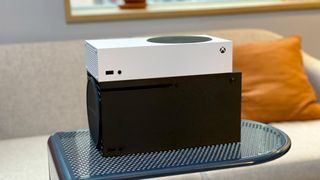
Now nearly two years into its lifespan, the Xbox Series X is the one Xbox console to rule them all, by being both a powerful current-generation machine but also a console that can run Xbox games dating back decades.
It's fast SSD, general 4K resolution gaming and game performance that sits around 60 fps makes it very much a console to buy today. Sure it's not cheap, but it undercuts an equivalent gaming PC and can also tap into Xbox Cloud Gaming on top, making it a superbly versatile machine.
In sort, this is definitely the current-gen Xbox you should consider if you want the best gaming experience from a games console that ins't the PS5.
Roland Moore-Colyer a Managing Editor at Tom’s Guide with a focus on news, features and opinion articles. He often writes about gaming, phones, laptops and other bits of hardware; he’s also got an interest in cars. When not at his desk Roland can be found wandering around London, often with a look of curiosity on his face.
-
smalltown2 Are you able to comment on screen aspect ratios that are available on the Xbox series X ?Reply
I have been debating on whether or not to purchase an ultra widescreen monitor, and was hoping to see a 21:9 aspect ration on the Xbox series X. -
hasper567 Was looking forward to the XBox Series X system.Reply
However, the Blu-ray player skipped audio on the first day.
Disc was brand new....(Yakuza Princess Blu-ray 4K Ultra HD).
The second day, tying a different brand new Blu-ray 4K UHD disk (No Time to Die).
The player skipped audio multiple times and then the video went competely black.
I believe my Xbox Series X was made May 2022.
OS Build 10.0.22000.4975
There are numerous internet reports of defective Blu-rayer players in the XBox Series X.
Also, good to note is that the Blu-ray app on the XBox Series X is outdated and in desperate need of an update.
I returned the XBox Series X the same day.


